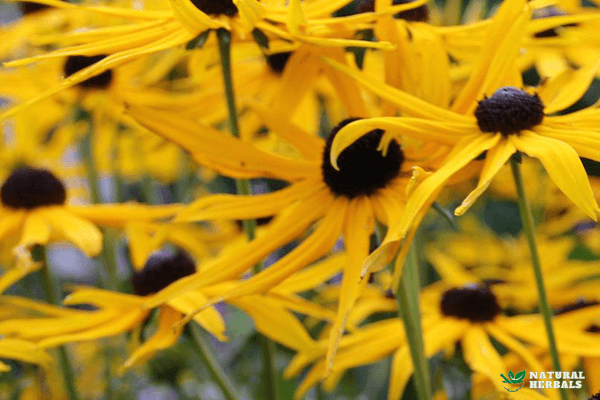
The versatile medicinal plant, Arnica (full name ‘arnica montana' and also known as fall grass or woolly leech), has many health benefits. Arnica helps with bruises, inflammation of the mucous membrane of the mouth and throat, boils, sunburn and insect bites, among other things. Rheumatic muscle and joint complaints can also be treated well with arnica ointment.
The medicinal plant should only be applied externally. The healing powers of arnica have been known since the early 16th century.
What is arnica?
The plant
Arnica is a versatile medicinal plant. It is also known by the names fall weed or woolly leech. Botanically, it belongs to the to the composite family (Asteraceae). Arnica is a deciduous, herbaceous plant whose yellow flowers have a particularly aromatic scent.
The length of varies between 20 and 60 centimeters and depends on the variety and origin The plant is characterized by a simple, branched stem, which is in possession of one or two pairs of leaves. The flower heads are 6-8 cm wide.
Habitat
Arnica is found in the mountainous regions of Europe, Siberia and northern Europe. That means you'll find the plant in the Alps, the Pyrenees, in the Balkans and in southern Scandinavia.
In Central Europe, where the flowering period lasts from May to August, the plant is covered by the Nature Protection Act. It can thrive especially on acidic and lime-poor soil. Arnica also feels good on forest burns, as well as in valleys and altitudes up to 2800 meters.
In the US Arnica plants, members of the daisy family, include species adapted to a range of climates and conditions. Arnica grows in Sunset's Climate Zones 1 to 9. Some species are found only in Alaska and Canada; others, like chamisso arnica (Arnica chamissonis Less.)
Health Benefits
The ancient medicinal plant is applied various disorders and diseases, such as:
- Inflammation of the oral mucosa in the mouth (mouth infection) and pharynx (laryngitis)
- Boils
- Diaper rash
- Inflammation resulting from insect bites
- Rheumatic muscle and joint pain
- Superficial phlebitis or vein inflammation
- Bruises, contusions, and sprains
- Superficial burns (including sunburns)
- Swellings
- Hemorrhoids
Only the flowers are used for medicinal purposes. They contain sesquiterpene lactones (substances that occur naturally in certain types of flowers) of the helenanolide type, flavonoids, essential oil (containing thymol), phenolic carboxylic acids, and coumarins (anticoagulants). These ingredients have anti-inflammatory, disinfectant, and analgesic effects.
Applications of arnica
All preparations containing arnica are used externally and only on non-damaged skin. Arnica ointment, tincture, gel, cream, massage oil, mouthwash, and arnica oil are available.
Ingredients, effects, and dosage
The flowers of arnica contain the most important medicinal ingredients: the sesquiterpene lactones. The sesquiterpene lactones include, for example, the esters of helenalin, which gives a bitter taste.
However, not every arnica plant has the same composition of sesquiterpene lactones, because the amount of these ingredients depends on the origin of the plant. For example, the flowers of Spanish arnica contain very little of this active ingredient.
Other valuable arnica ingredients are flavonoids, flavonols, essential oils and triterpenes. However, the active ingredients arnicin and flavonoids as well as the essential oils are not only found in the flowers, but also in other parts of the plant.
Not to be underestimated arnica has a high content of fatty acids, polysaccharides, cinnamic acids, caffeic acids and coumarins. The concentration of caffeic acids also depends on the height of the plant.
The peculiarity of arnica lies in the fact that its range of application is very wide. So it is not only used to treat muscle and joint pain. Even with bruises, swelling or hemorrhoids, you can benefit from the healing power of this plant.
Arnica owes its antiseptic effect to flavonoids and essential oils. The substance helenalin works well for treating bruises. It also has an anti-inflammatory effect and prevents the formation of swelling.
In the production of herbal preparations, arnica flowers are used in fresh or dried form.
Side effects
Prolonged use of arnica-containing products may cause skin irritation and eczema. Application of arnica to damaged skin may cause skin inflammation with swelling and blistering.
When arnica preparations are applied improperly and/or too concentrated (such as undiluted tincture), you can develop toxic skin reactions with blistering and dying of skin tissue (necrosis).
When arnica is ingested, it can cause side effects such as diarrhea, dizziness, nosebleeds, and cardiac arrhythmia. Therefore, preparations of the medicinal plant should not be used internally. Homeopathic dilutions, however, are harmless.
What to look out for
You should not treat a large area with undiluted arnica tincture, as this can lead to skin inflammation with blistering. Therefore, always use diluted tinctures for larger areas of the skin. Insect bites, however, can be treated with undiluted tincture.
In case of allergy to composite family, arnica preparations should be avoided.
For the use of the medicinal plant during pregnancy and lactation and in children under twelve years of age, there are no known safety data anno 2022. Therefore, its use is not recommended for these groups.
Avoid direct contact of arnica with eyes and open wounds.
The post Arnica: health benefits, uses and side effects appeared first on Natural Herbal Recipes For Everyday Use.
Source:https://naturalherbals.net/herbs/arnica-health-benefits-uses-and-side-effects/
Comments
Post a Comment